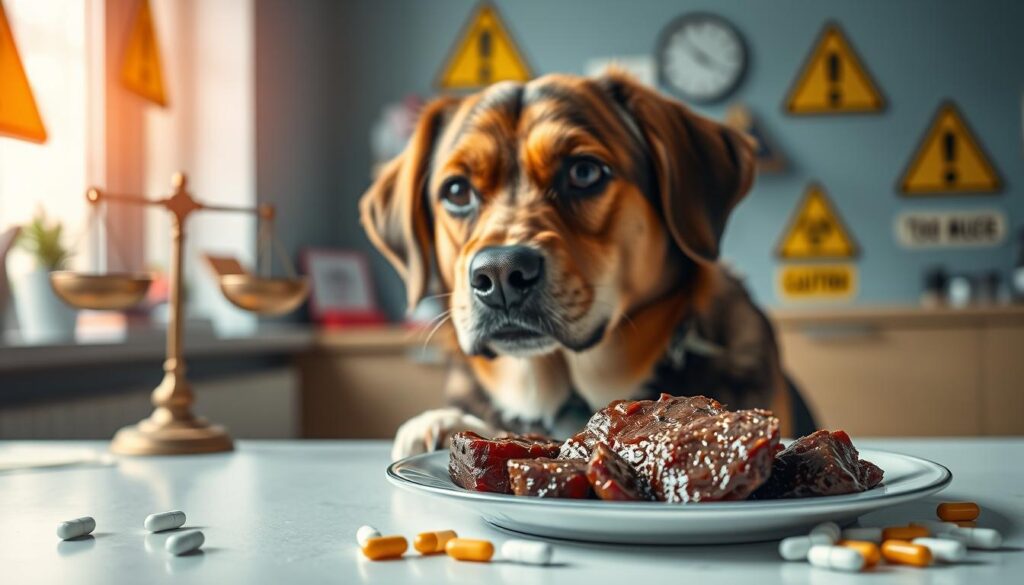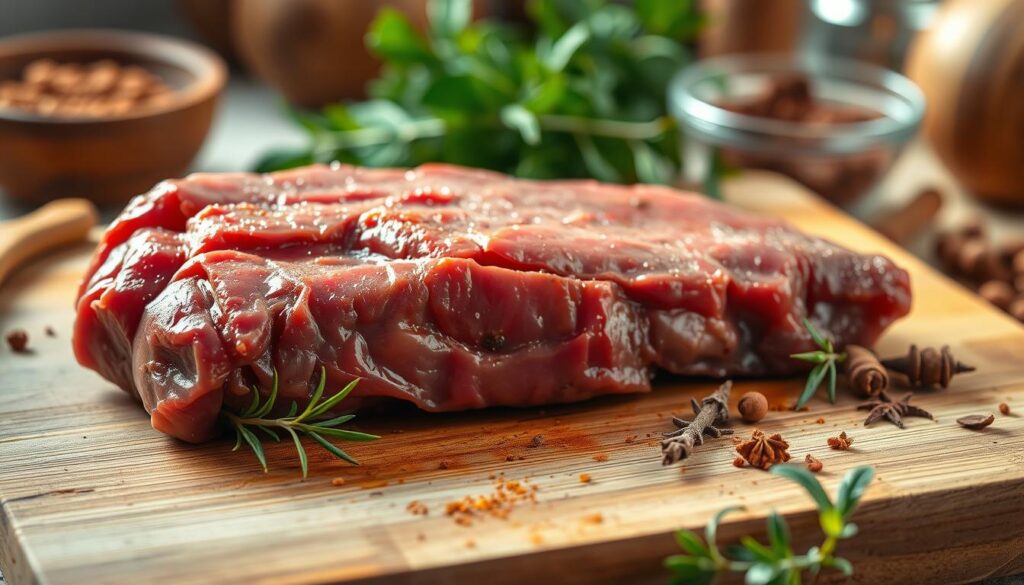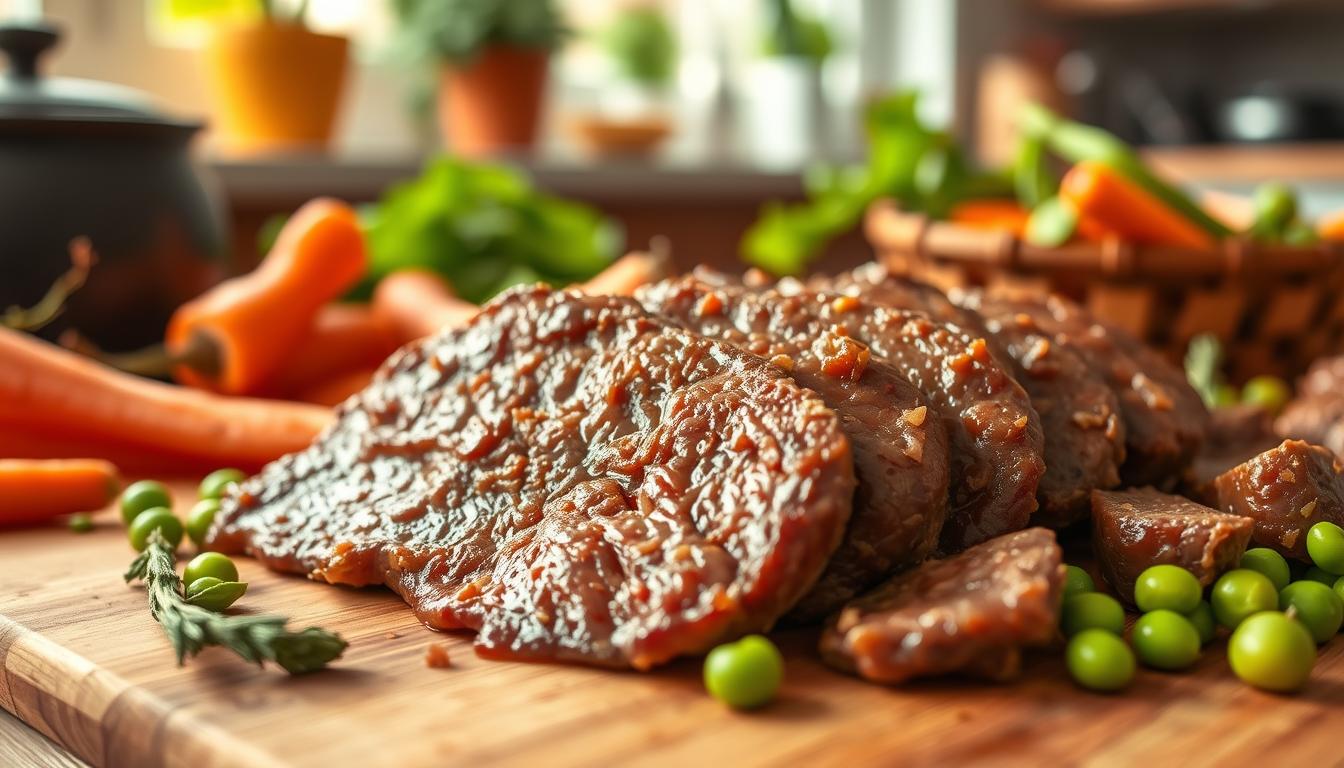I love giving my dog the best food. When I found out about liver’s benefits, I wanted to share it with everyone. Liver is a superfood for dogs, full of vitamins, minerals, and proteins that boost their health.
This guide will show you liver’s nutritional value, the types available, and how to add it to your dog’s meals. It’s perfect for both new and experienced pet owners. You’ll learn how to feed liver to your dog confidently.
Table of Contents
Understanding Liver as a Nutritional Powerhouse
Liver is packed with vitamins, minerals, and nutrients that are great for dogs. It comes from animals like chickens, cows, lambs, and pigs. This meat is full of iron, vitamin A, B vitamins, zinc, copper, and fatty acids.
Types of Liver Available for Dogs
There are many livers you can give to your dog. You can choose from chicken, beef, lamb, or pork liver. Each type has its own special nutrients that help keep your dog healthy.
- Chicken liver is packed with more nutrients than pork liver.
- Beef liver has more vitamin A than chicken liver. It’s good for your dog’s eyes and immune system.
- Lamb liver is rich in protein, iron, and vitamin B12. These help with energy and a healthy nervous system.
Nutritional Content Overview
Liver is full of nutrients that are good for your dog. It has:
- Protein – Liver is a great source of protein. It helps build and repair muscles.
- Vitamin A – Beef liver is especially rich in vitamin A. It’s important for vision, skin, and immune health.
- B Vitamins – Liver has B vitamins, especially B12. They help with energy and a healthy nervous system.
- Iron, Copper, and Zinc – These minerals help make red blood cells and keep the immune system strong.
Comparing Different Liver Sources
| Liver Type | Nutrient Highlights | Recommended Serving Size |
|---|---|---|
| Beef Liver | High in vitamin A, B vitamins, iron, copper, and zinc | Small dogs: 1 oz/week, Medium dogs: 2 oz/week, Large dogs: 3 oz/week |
| Chicken Liver | Higher in nutrients compared to pork liver | Small dogs: 1 oz/week, Medium dogs: 2 oz/week, Large dogs: 3 oz/week |
| Lamb Liver | Good source of protein, iron, and vitamin B12 | Small dogs: 1 oz/week, Medium dogs: 2 oz/week, Large dogs: 3 oz/week |
| Pork Liver | Lower in nutrients compared to other liver types | Small dogs: 1 oz/week, Medium dogs: 2 oz/week, Large dogs: 3 oz/week |
Knowing the nutritional differences between livers helps you choose the best one for your dog. This ensures they get the nutrients they need.
Can Dogs Eat Liver: Safety and Guidelines
Dogs can eat liver safely as part of a balanced diet. But, it’s key to prepare and portion it right to avoid health problems. Cooked liver is safer than raw to lower the risk of bacteria.
When giving liver to your dog, make sure it’s plain and without harmful extras like onions or garlic. Medium-sized dogs should get about an ounce (28g) of liver daily.
- Liver is packed with nutrients like iron, copper, and B vitamins, making it great for dogs.
- But, liver should only be 10% of a dog’s diet to avoid too much vitamin A.
- Too much vitamin A can harm dogs, causing bone and joint issues.
- Puppies can have small amounts of liver, but they need a balanced puppy diet too.
- Some dogs might react to liver with symptoms like vomiting or skin issues.
For your dog’s safety, choose fresh, cooked liver over raw. You can give them different types of liver like lamb’s, chicken, or pork in small amounts. Each type has its own nutritional benefits.
| Liver Type | Key Nutrients | Feeding Recommendations |
|---|---|---|
| Beef Liver | Iron, vitamin B12, folic acid | Ideal for boosting energy, but should be limited to 5% of the diet |
| Chicken Liver | Protein, vitamin A, selenium | Great for immune health, but also limited to 5% of the diet |
| Pork Liver | Vitamin B1, vitamin D | Higher in fat, so should be fed in smaller quantities |
| Lamb Liver | Vitamin A, iron, zinc | Rich in nutrients but also higher in fat, requiring moderation |
Adding liver to your dog’s diet should be done carefully. Stick to the recommended amounts to keep your dog healthy and happy.
Health Benefits of Feeding Liver to Dogs
Adding liver for dogs to their diet can greatly benefit your pet. Liver is packed with vitamins, minerals, and proteins. These nutrients are key for your dog’s health.
Immune System Support
Liver is full of vitamins A, B, and C, and minerals like iron, copper, and zinc. These help keep your dog’s immune system strong. They help fight off infections and diseases.
Vision and Coat Health
Vitamin A in liver is great for your dog’s eyes and coat. It helps the eyes work right and keeps the skin and fur shiny.
Blood and Heart Benefits
Liver is rich in iron, important for healthy red blood cells. This supports the heart and ensures the body gets enough oxygen. B vitamins in liver also boost energy, brain function, and nerve health.
Feeding liver for dogs can improve their health in many ways. It boosts the immune system and supports vision, coat, and heart health. Always introduce liver slowly and watch for any signs of intolerance.
Proper Preparation Methods for Dog Liver
Feeding liver to your dog needs careful preparation. Always cook liver well to avoid foodborne illnesses. Boiling or steaming are best, as they keep nutrients and avoid extra fats or seasonings.
After cooking, cut the liver into small pieces to avoid choking. This makes it easier for your dog to eat and digest. You can also freeze cooked liver for later, making it a quick meal addition.
Choose fresh, quality liver treats for dogs from trusted sources. Don’t add seasonings, salt, or oil, as they can harm your dog. By following these steps, you can safely add liver benefits to your dog’s diet.
Cooking Methods for Dog Liver
- Boiling: Boil the liver until it’s cooked through, typically around 10-15 minutes.
- Steaming: Place the liver in a steamer basket and steam for 15-20 minutes until fully cooked.
- Baking: Preheat your oven to 350°F (175°C) and bake the liver for 20-30 minutes, flipping halfway through.
- Air-frying: Air-fry the liver at 400°F (200°C) for 8-12 minutes, shaking the basket halfway through.
Risks and Potential Side Effects
Liver is a superfood for dogs, but too much can be harmful. It’s important to know the risks to keep your dog healthy. Make sure to check with your vet about adding liver to their diet.
Vitamin A Toxicity Concerns
Feeding too much liver can cause vitamin A toxicity. This can harm bones, joints, and the digestive system. It’s key to watch how much liver your dog eats to avoid these problems.
Signs of Liver Overconsumption
- Loose stools or diarrhea
- Vomiting
- Lethargy or decreased energy levels
When to Avoid Feeding Liver
Some dogs should not eat liver. Dogs with allergies or health issues should avoid it. Also, dogs at risk for kidney stones should not eat too much liver.
Knowing the risks helps you keep your dog safe. Always talk to your vet about how much liver is okay for your dog.

Recommended Serving Sizes and Frequency
Feeding liver to your dog should be done with care. Liver should not be more than 5-10% of their daily food. For a medium-sized dog, about an ounce (28g) of liver is safe. But, the right amount depends on your dog’s size and weight.
Smaller dogs need less, while bigger dogs can have more. Liver can be a daily part of their diet or a special treat. Always introduce new foods, like liver, slowly. This helps prevent any upset stomachs.
| Dog’s Weight | Recommended Liver Portion (per day) |
|---|---|
| Small Breeds (up to 10 lbs) | 1/2 – 1 tablespoon |
| Medium Breeds (11-25 lbs) | 1 – 2 ounces |
| Large Breeds (over 25 lbs) | 2 – 3 ounces |
These serving sizes are just a starting point. Your dog’s specific needs might require different portions. Always talk to your vet before changing your dog’s diet, especially if they have health issues.
Raw vs. Cooked Liver for Dogs
There’s a debate about whether to feed dogs raw or cooked liver. Many pet owners prefer raw diets. But, cooked liver is safer because it has less risk of bacterial contamination.
Safety Considerations for Raw Feeding
Raw beef liver is safer than raw chicken liver. But, it’s still important to be careful. If you’re thinking about a raw diet, talk to your vet first. Make sure to handle and store food properly to avoid foodborne illnesses.
Cooking Methods and Tips
- Boiling, steaming, or baking liver without fats or seasonings is safest for dogs.
- Don’t fry liver or use oils. It adds too many fats and calories.
- Light cooking helps reduce bacterial risks while keeping liver’s nutrients.
Adding raw liver for dogs or feeding liver to dogs to their diet can be very beneficial. But, it’s crucial to do it carefully and with your vet’s advice. By choosing the right cooking methods and amounts, you can make sure your dog gets the best from this superfood.

| Liver Type | Nutritional Benefits | Potential Risks |
|---|---|---|
| Beef Liver | High in iron, copper, zinc, and vitamins A, B12, and folate | Can cause vitamin A toxicity if fed in excess |
| Chicken Liver | Rich in protein, vitamin A, and essential fatty acids | Higher risk of bacterial contamination compared to beef liver |
| Lamb Liver | Packed with vitamins and minerals, including selenium and copper | May cause allergic reactions in some dogs |
Incorporating Liver into Your Dog’s Diet
Liver is a great addition to your dog’s diet. It’s packed with vitamins, minerals, and protein. You can add it to their meals in different ways to make sure they get all the good stuff.
Using liver treats for dogs is a simple option. Freeze-dried liver treats are a concentrated source of nutrients. You can also bake your own homemade liver dog treats by cooking liver slices until crispy.
For a bigger liver meal, try adding it as a topping or mix-in. Start with a little liver and slowly add more to avoid upset stomachs. You can also blend liver into homemade dog food or make a nutritious pâté.
| Liver Type | Nutritional Benefits | Recommended Serving Size |
|---|---|---|
| Beef Liver | High in iron, vitamin B12, and folic acid | Up to 5% of your dog’s total diet |
| Chicken Liver | Milder taste and softer texture, suitable for sensitive dogs | Up to 5% of your dog’s total diet |
| Pork Liver | Rich in vitamin B1 (thiamine) and vitamin D | Up to 2.5% of your dog’s total diet |
| Lamb Liver | High in vitamin A, iron, and zinc | Up to 2.5% of your dog’s total diet |
Start with small amounts of liver and slowly increase it to avoid digestive problems. Too much liver can cause vitamin A toxicity. By mixing liver with other foods, you can give your dog a balanced diet.
Conclusion
Liver can be a highly nutritious addition to your dog’s diet. It’s full of vitamins, minerals, and nutrients. These can help your dog’s health, from their immune system to their coat and vision. But, it’s important to feed liver in moderation to avoid vitamin A toxicity.
When adding liver for dogs, remember the serving sizes and how often to give it. Try to keep liver at about 5% of your dog’s daily food. Offer it as a treat no more than two to three times a week. Cooking the liver properly before feeding can also help with safety.
Knowing the benefits of liver for dogs and following the right guidelines is key. This way, you can safely add this nutrient-rich protein to your pet’s diet. With a balanced approach, you can support your dog’s wellbeing and give them the nutrients they need to thrive.

